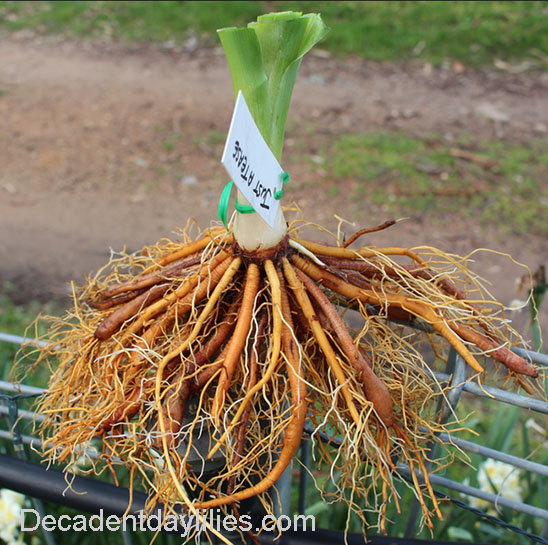Daylilies are not bulbs,
although some people often referred them as daylily bulbs and even sell them as daylily bulbs they’re not true bulbs. Lets clarify why a daylily plant is not a bulb.
A daylily has a perennial growth habit with underground root structures that grow out from the crown and down into the soil anchoring the plant into a stable spot in the ground. Daylilies are able to store nutrients in their roots as underground storage organs, this makes them somewhat drought tolerant and are able to let the storage supply out when the stored food is needed. Because of their strong root systems, sometimes gardeners grow them as mass plantings on steep embankments, retaining walls and slopes; this can help to control soil erosion.
In summer daylily plants photosynthesis is a great deal more, plants store photosynthesis and then utilise it when the weather is unfavourable; the daylilies fibrous roots release their storage during severe winter conditions, during winter snow or cold bleak winter days when there is not much sunshine.
A daylily will not grow from its roots alone, it must have a crown or part of a crown to grow either roots or foliage. Having said this, daylilies do not have tubers either even though sometimes you will find a thickening along or at the end of the daylily roots that look like an oblong small tuber, this can even be similar to a small dahlia tuber, so daylilies are not called daylily tubers either.
The reason why some daylilies have thickening or small tubers on the end of the roots is a good sign that the daylilies have not been watered deep enough, which in turn causes the daylilies to make short shallow roots with tubers right on the ends of the roots. So if you want to make tubers on the end of your daylily roots there is no trick to this, just water your daylilies shallowly. If you water your daylilies deeply like daylilies should be watered this does not happen.
Best examples of bulbs are spring bulbs, tulips, daffodils, hippeastrums, alliums, grape hyacinths and garlic, these bulbs are round and come in many different sizes from large to small, they also do have a paper like covering, this also helps to protect the bulbs.
The fact that daylilies are not lilies with ‘true bulb’ structures is something that you need to take into consideration when it comes to daylilies planting time, daylilies have a very large long root system when planting, the daylilies planting depth must be dug at least 1 foot deep for the daylily roots to grow into. In order to get the most of these plants, you should consider these points. Proper care and maintenance with deep watering is the best method to improve a good deep daylily root system.
Are you still confused about daylilies having roots or bulbs? Pictured is one of our daylily plants ready to be sent to a customer in Western Australia, you can see clearly that daylilies have roots and not a bulb.
Make sure you grow, plant and care for your daylilies as tuberous roots rather than daylily bulbs, this will guarantee, you do get to enjoy all of the benefits of these beautiful flowers called daylilies.


Comments
Pingback: How To Identify Daylilies Daylily Identification Guide With Pictures - Decadent Daylilies Australia